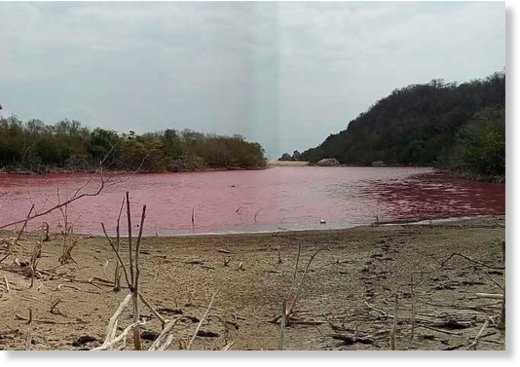A lagoon situated in Huatalco, Mexico has turned blood red within the last 10 days.
The reddish water of 'La Salina' lagoon impacts residents' life and kills wildlife in the area.
After the mysterious overnight disappearance of a river near Veracruz, Mexico, it's now a lagoon that has unexpectedly turned color from green to red.
Scientists believe the color is a result of a red tide, a phenomenon in which estuarine, marine, or fresh water algae accumulate rapidly in the water column, which changes the color of the surface water.
The production of natural toxins and depletion of dissolved oxygen could be responsible for wildlife mortalities of marine and coastal species of fish, birds, marine mammals, and other organisms around the lagoon.
Although red tides appear to be natural in some locations, residents believe that this algae blloom is the result of increased nutrient loading from human activities and low precipitation. Indeed, the 'La Salina' lagoon is known for being highly polluted and the sewage plant is not working properly.

Experts from the Universidad del Mar (UMAR) explained the phenomenon as algal bloom caused by pollution, lack of rain and high sea temperatures.
Residents are reporting loss of marine life and fear their health is being threatened. They say local authorities are not offering a solution to their problem and are calling Greenpeace, the World Wildlife Fund and the Environmental Protection Agency to address the situation.
Local media report that environmentalists have been warning about severe pollution in the lagoon for several years.
The "La Salina" lagoon in Huatulco, Mexico, known for its pollution, has changed its color into blood red on February 25, 2016.
Experts from the Universidad del Mar (UMAR) explained the phenomenon as algal bloom caused by pollution, lack of rain and high sea temperatures.
Residents are reporting loss of marine life and fear their health is being threatened. They say local authorities are not offering a solution to their problem and are calling Greenpeace, the World Wildlife Fund and the Environmental Protection Agency to address the situation.
Local media report that environmentalists have been warning about severe pollution in the lagoon for several years.
Harmful algal blooms, or HABs, occur when colonies of algae - simple plants that live in the sea and freshwater - grow out of control while producing toxic or harmful effects on people, fish, shellfish, marine mammals, and birds. The human illnesses caused by HABs, though rare, can be debilitating or even fatal, NOAA explains.
While many people call these blooms 'red tides,' scientists prefer the term harmful algal bloom.
HABs occur naturally, but human activities that disturb ecosystems seem to play a role in the increased occurrence of some blooms. Increased nutrient loadings and pollution, food web alterations, introduced species, water flow modifications, and climate change have all been implicated.
Source:
http://www.sott.net/article/313800-Lagoon-becomes-blood-red-in-Mexico?utm_content=buffer4090b&utm_medium=social&utm_source=facebook.com&utm_campaign=buffer
The reddish water of 'La Salina' lagoon impacts residents' life and kills wildlife in the area.
After the mysterious overnight disappearance of a river near Veracruz, Mexico, it's now a lagoon that has unexpectedly turned color from green to red.
Scientists believe the color is a result of a red tide, a phenomenon in which estuarine, marine, or fresh water algae accumulate rapidly in the water column, which changes the color of the surface water.
The production of natural toxins and depletion of dissolved oxygen could be responsible for wildlife mortalities of marine and coastal species of fish, birds, marine mammals, and other organisms around the lagoon.
Although red tides appear to be natural in some locations, residents believe that this algae blloom is the result of increased nutrient loading from human activities and low precipitation. Indeed, the 'La Salina' lagoon is known for being highly polluted and the sewage plant is not working properly.

Experts from the Universidad del Mar (UMAR) explained the phenomenon as algal bloom caused by pollution, lack of rain and high sea temperatures.
Residents are reporting loss of marine life and fear their health is being threatened. They say local authorities are not offering a solution to their problem and are calling Greenpeace, the World Wildlife Fund and the Environmental Protection Agency to address the situation.
Local media report that environmentalists have been warning about severe pollution in the lagoon for several years.
The "La Salina" lagoon in Huatulco, Mexico, known for its pollution, has changed its color into blood red on February 25, 2016.
Experts from the Universidad del Mar (UMAR) explained the phenomenon as algal bloom caused by pollution, lack of rain and high sea temperatures.
Residents are reporting loss of marine life and fear their health is being threatened. They say local authorities are not offering a solution to their problem and are calling Greenpeace, the World Wildlife Fund and the Environmental Protection Agency to address the situation.
Local media report that environmentalists have been warning about severe pollution in the lagoon for several years.
Harmful algal blooms, or HABs, occur when colonies of algae - simple plants that live in the sea and freshwater - grow out of control while producing toxic or harmful effects on people, fish, shellfish, marine mammals, and birds. The human illnesses caused by HABs, though rare, can be debilitating or even fatal, NOAA explains.
While many people call these blooms 'red tides,' scientists prefer the term harmful algal bloom.
HABs occur naturally, but human activities that disturb ecosystems seem to play a role in the increased occurrence of some blooms. Increased nutrient loadings and pollution, food web alterations, introduced species, water flow modifications, and climate change have all been implicated.
Source:
http://www.sott.net/article/313800-Lagoon-becomes-blood-red-in-Mexico?utm_content=buffer4090b&utm_medium=social&utm_source=facebook.com&utm_campaign=buffer

Post a Comment